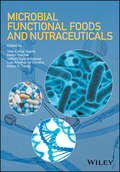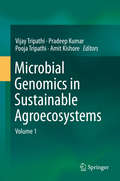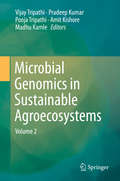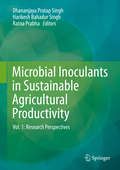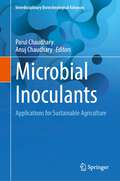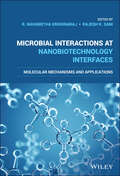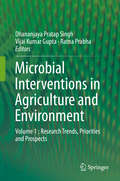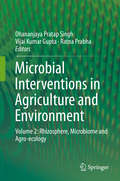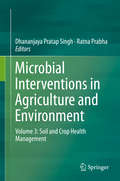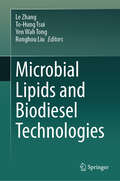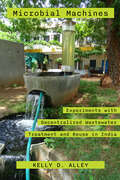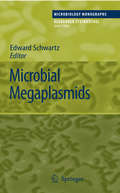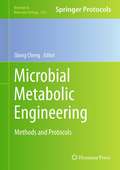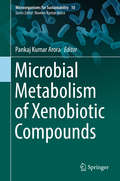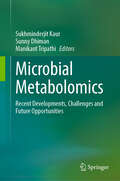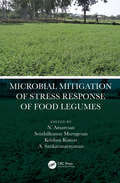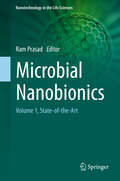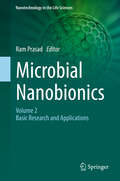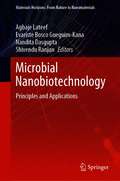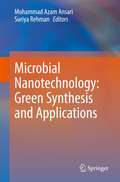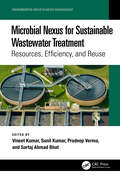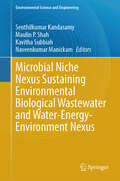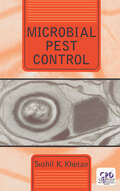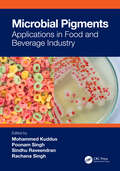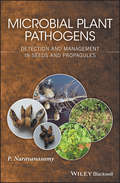- Table View
- List View
Microbial Functional Foods and Nutraceuticals
by Maria G. Tuohy Vijai Kumar Gupta Helen Treichel Volha Olga Shapaval Luiz Antonio de OliveiraShowcases the recent advances in microbial functional food applications across food science, microbiology, biotechnology, and chemical engineering Microbial technology plays a key role in the improvement of biotechnology, cosmeceuticals, and biopharmaceutical applications. It has turned into a subject of expanding significance because new microbes and their related biomolecules are distinguished for their biological activity and health benefits. Encompassing both biotechnology and chemical engineering, Microbial Functional Foods and Nutraceuticals brings together microbiology, bacteria, and food processing/mechanization, which have applications for a variety of audiences. Pharmaceuticals, diagnostics, and medical device development all employ microbial food technology. The book addresses the recent advances in microbial functional foods and associated applications, providing an important reference work for graduates and researchers. It also provides up-to-date information on novel nutraceutical compounds and their mechanisms of action—catering to the needs of researchers and academics in food science and technology, microbiology, chemical engineering, and other disciplines who are dealing with microbial functional foods and related areas. Microbial Functional Foods and Nutraceuticals is: Ground-breaking: Includes the latest developments and research in the area of microbial functional foods and nutraceuticals Multidisciplinary: Applicable across food science and technology, microbiology, biotechnology, chemical engineering, and other important research fields Practical and academic: An important area of both academic research and new product development in the food and pharmaceutical industries Microbial Functional Foods and Nutraceuticals is an ideal resource of information for biologists, microbiologists, bioengineers, biochemists, biotechnologists, food technologists, enzymologists, and nutritionists.
Microbial Genomics in Sustainable Agroecosystems: Volume 1
by Pradeep Kumar Vijay Tripathi Pooja Tripathi Amit KishoreIn recent decades, significant advances in new methodologies like DNA sequencing and high-throughput sequencing have been used to identify microorganisms and monitor their interactions with different environments. Microbial genomics techniques are opening new approaches to microbiology by revealing how microorganisms affect human beings and the environment. This book covers four major areas: 1) Environmental microbial genomics, 2) Microbial genomics in human health, 3) Microbial genomics in crop improvement and plant health protection, and 4) Genome analysis of microbial pathogens. Within these areas, the topics addressed include: microbial genome diversity, evolution, and microbial genome sequencing; bioinformatics and microarray-based genomic technologies; functional genomics of bioremediation of soil and water from organic and inorganic pollutants and carbon management; functional genomics of microbial pathogens and relevant microorganisms; functional genomics of model microorganisms; and applied functional genomics. Given its scope, the book offers a comprehensive source of information on the latest applications of microorganisms and microbial genomics to enhance the sustainability of agriculture and the environment.
Microbial Genomics in Sustainable Agroecosystems: Volume 2
by Pradeep Kumar Madhu Kamle Vijay Tripathi Pooja Tripathi Amit KishoreToday, microbiology is a rapidly growing discipline in the life sciences, and the technologies are evolving on a virtually daily basis. Next-generation sequencing technologies have revolutionized microbial analysis, and can help us understand the biology and genomic diversity of various bacterial species with significant impacts on agro-ecosystems. In addition, advances in molecular biology and microbiology techniques hold the potential to improve the productivity and sustainability of agriculture and forestry.This new volume addresses the role of microbial genomics in understanding the living systems that exist in the soil and their interactions with plants, an aspect that is also important for crop improvement. The topics covered focus on a deeper and clearer understanding of how microbes cause diseases, the genome-based development of novel antibacterial agents and vaccines, and the role of microbial genomics in crop improvement and agroforestry. Given its scope, the book offers a valuable resource for researchers and students of agriculture and infectious biology.
Microbial Inoculants in Sustainable Agricultural Productivity
by Harikesh Bahadur Singh Dhananjaya Pratap Singh Ratna PrabhaThe performance of crops in the soil largely depends on the physico-chemical components of the soil, which regulate the availability of nutrients as well as abiotic and biotic stresses. Microbes are the integral component of any agricultural soil, playing a vital role in regulating the bioavailability of nutrients, the tolerance to abiotic and biotic stresses and management of seed-borneand soil-borne plant diseases. The second volume of the book Microbial Inoculants in Sustainable Agricultural Productivity - Functional Applications reflects the pioneering efforts of eminent researchers to explore the functions of promising microbes as microbial inoculants, establish inoculants for field applications and promote corresponding knowledge among farming communities. In this volume, readers will find dedicated chapters on the role of microbes as biofertilizers and biopesticides in the improvement of crop plants, managing soil fertility and plant health, enhancing the efficiency of soil nutrients and establishing systemic phytopathogen resistance in plants, as well as managing various kinds of plant stress by applying microbial inoculants. The impact of microbial inoculants on the remediation of heavy metals, soil carbon sequestration, function of rhizosphere microbial communities and remediation of heavy metal contaminated agricultural soils is also covered in great detail. In this Volume, a major focus is on the approaches, strategies, advances and technologies used to develop suitable and sustainable delivery systems for microbial inoculants in field applications. Subsequent chapters investigate the role of nanomaterials in agriculture and the nanoparticle-mediated biocontrol of nematodes. An overview of the challenges facing the regulation and registration of biopesticides in India rounds out the coverage.
Microbial Inoculants: Applications for Sustainable Agriculture (Interdisciplinary Biotechnological Advances)
by Parul Chaudhary Anuj ChaudharyThis book discusses the role of microbes in agriculture for plant attributes, soil fertility, and bio-remediation, which aid in sustainable agriculture. Nowadays, due to increase in human population, it is essential to increase food productivity in the near future, but exhaustive non-sustainable agricultural practices such as the usage of agrochemicals threaten food security, the economy, and the environment globally. Soil deterioration is the most serious environmental threat to food production, resulting in poverty and hunger in developing countries. As a result, the global community has faced challenges regarding the development of ecologically sound, efficient, and long-term alternative options to meet rising food requirements. Therefore, to contribute to food security, the advancement of sustainable and innovative modern agriculture aimed at addressing environmental, economic, and social challenges connected with present intense non-sustainable agriculture practices is required. As a result, beneficial microbial inoculants will be widely used in the development of new strategies to increase sustainable food production. Bioinoculant application helps to provide nutrients that directly support soil health and sustainable food production. Hence, this book offers the role of microbial inoculants for better agronomical performance for sustainable advancement in agriculture and also pays attention to soil health improvement for extensive period benefits. The book will be highly recommended for agriculture microbiologists, agronomists, plant pathologists, and related areas.
Microbial Interactions at Nanobiotechnology Interfaces: Molecular Mechanisms and Applications
by Rajesh K. Sani R. Navanietha KrishnarajMICROBIAL INTERACTIONS AT NANOBIOTECHNOLOGY INTERFACES This book covers a wide range of topics including synthesis of nanomaterials with specific size, shape, and properties, structure-function relationships, tailoring the surface of nanomaterials for improving the properties, interaction of nanomaterials with proteins/microorganism/eukaryotic cells, and applications in different sectors. This book also provides a strong foundation for researchers who are interested to venture into developing functionalized nanomaterials for any biological applications in their research. Practical concepts such as modelling nanomaterials, and simulating the molecular interactions with biomolecules, transcriptomic or genomic approaches, advanced imaging techniques to investigate the functionalization of nanomaterials/interaction of nanomaterials with biomolecules and microorganisms are some of the chapters that offer significant benefits to the researchers.
Microbial Interventions in Agriculture and Environment: Volume 1 : Research Trends, Priorities and Prospects
by Vijai Kumar Gupta Dhananjaya Pratap Singh Ratna PrabhaMicrobial communities and their functions play a crucial role in the management of ecological, environmental and agricultural health on the Earth. Microorganisms are the key identified players for plant growth promotion, plant immunization, disease suppression, induced resistance and tolerance against stresses as the indicative parameters of improved crop productivity and sustainable soil health. Beneficial belowground microbial interactions with the rhizosphere help plants mitigate drought and salinity stresses and alleviate water stresses under the unfavorable environmental conditions in the native soils. Microorganisms that are inhabitants of such environmental conditions have potential solutions for them. There are potential microbial communities that can degrade xenobiotic compounds, pesticides and toxic industrial chemicals and help remediate even heavy metals, and thus they find enormous applications in environmental remediation. Microbes have developed intrinsic metabolic capabilities with specific metabolic networks while inhabiting under specific conditions for many generations and, so play a crucial role. The book Microbial Interventions in Agriculture and Environment is an effort to compile and present a great volume of authentic, high-quality, socially-viable, practical and implementable research and technological work on microbial implications. The whole content of the volume covers protocols, methodologies, applications, interactions, role and impact of research and development aspects on microbial interventions and technological outcomes in prospects of agricultural and environmental domain including crop production, plan-soil health management, food & nutrition, nutrient recycling, land reclamation, clean water systems and agro-waste management, biodegradation & bioremediation, biomass to bioenergy, sanitation and rural livelihood security. The covered topics and sub-topics of the microbial domain have high implications for the targeted and wide readership of researchers, students, faculty and scientists working on these areas along with the agri-activists, policymakers, environmentalists, advisors etc. in the Government, industries and non-government level for reference and knowledge generation.
Microbial Interventions in Agriculture and Environment: Volume 2: Rhizosphere, Microbiome and Agro-ecology
by Vijai Kumar Gupta Dhananjaya Pratap Singh Ratna PrabhaMicrobial communities and their functions play a crucial role in the management of ecological, environmental and agricultural health on the Earth. Microorganisms are the key identified players for plant growth promotion, plant immunization, disease suppression, induced resistance and tolerance against stresses as the indicative parameters of improved crop productivity and sustainable soil health. Beneficial belowground microbial interactions with the rhizosphere help plants mitigate drought and salinity stresses and alleviate water stresses under the unfavorable environmental conditions in the native soils. Microorganisms that are inhabitants of such environmental conditions have potential solutions for them. There are potential microbial communities that can degrade xenobiotic compounds, pesticides and toxic industrial chemicals and help remediate even heavy metals, and thus they find enormous applications in environmental remediation. Microbes have developed intrinsic metabolic capabilities with specific metabolic networks while inhabiting under specific conditions for many generations and, so play a crucial role. The book Microbial Interventions in Agriculture and Environment is an effort to compile and present a great volume of authentic, high-quality, socially-viable, practical and implementable research and technological work on microbial implications. The whole content of the volume covers protocols, methodologies, applications, interactions, role and impact of research and development aspects on microbial interventions and technological outcomes in prospects of agricultural and environmental domain including crop production, plan-soil health management, food & nutrition, nutrient recycling, land reclamation, clean water systems and agro-waste management, biodegradation & bioremediation, biomass to bioenergy, sanitation and rural livelihood security. The covered topics and sub-topics of the microbial domain have high implications for the targeted and wide readership of researchers, students, faculty and scientists working on these areas along with the agri-activists, policymakers, environmentalists, advisors etc. in the Government, industries and non-government level for reference and knowledge generation.
Microbial Interventions in Agriculture and Environment: Volume 3: Soil and Crop Health Management
by Dhananjaya Pratap Singh Ratna PrabhaMicrobial communities and their multi-functionalities play a crucial role in the management of soil and plant health, and thus help in managing agro-ecology, the environment and agriculture. Microorganisms are key players in N-fixation, nutrient acquisition, carbon sequestration, plant growth promotion, pathogen suppression, induced systemic resistance and tolerance against stresses, and these parameters are used as indicators of improved crop productivity and sustainable soil health. Beneficial belowground microbial interactions in the rhizosphere help plants combat abiotic challenges in the unfavourable environmental conditions of native soils. These microorganisms and their products offer potential solutions for agriculture in problematic areas since they are able to degrade xenobiotic compounds, pesticides and toxic chemicals and help remediate heavy metals in the rhizosphere and so make deteriorated soils suitable for crop production. This book compiles the latest research on the role of microbes in the rhizosphere and agro-ecology, covering interaction mechanisms, microbe-mediated crop production, plant and soil health management, food and nutrition, nutrient recycling, land reclamation, clean water systems, agro-waste management, biodegradation, bioremediation, biomass and bioenergy, sanitation and rural livelihood security. It is a comprehensive reference resource for agricultural activists, policymakers, environmentalists and advisors working for governments, non-governmental organizations and industries, helping them update their knowledge of this important, but often neglected, research area.
Microbial Lipids and Biodiesel Technologies
by Le Zhang To-Hung Tsui Yen Wah Tong Ronghou LiuThis book, belonging to energy discipline, summarized the latest research progress in the development of microbial lipids and biodiesel technologies. This book introduced the concept and development of microbial lipids and biodiesel technologies, the microbial lipid technology based on oleaginous yeasts, filamentous fungi, microalgae, bacteria, and thraustochytrids. Meanwhile, this book introduced the inhibition and removal of lignocellulosic hydrolysis inhibitors on microbial fermentation for lipid production, the isolation and screening of high-yield strains of oleaginous microorganisms, the use of metabolic engineering to transform oleaginous microorganisms, the process engineering technologies for optimization and process improvement, the harvesting of microbial cells and the extraction of microbial lipids, the production of crude biodiesel by esterification of microbial lipids, the biodiesel purification technology as well as the challenges and prospects of the industrialization of biodiesel technology based on microbial lipids. Reading this book will help readers comprehensively understand the latest developments in the field of "microbial lipids and biodiesel technologies". This book takes into account the relevant practical engineering technologies and the latest basic scientific research, and can be used as a reference for the researchers, engineers, investors, policy-makers, and students engaged in clean energy, microbial lipids and biodiesel industries.
Microbial Machines: Experiments with Decentralized Wastewater Treatment and Reuse in India
by Kelly D. AlleyAround 2004, members of governmental and nongovernmental organizations, science institutes, and private companies throughout India began brainstorming and then experimenting with small-scale treatment systems that could produce usable water from wastewater. Through detailed case studies, Microbial Machines describes how residents, workers, and scientists interact with technology, science, and engineering during the processes of treatment and reuse. Using a human-machine-microbe framework, Kelly Alley explores the ways that people's sensory perceptions of water—including disgust—are dynamic and how people use machines and microbes to digest wastewater. A better understanding of how the human and nonhuman interact in these processes will enable people to generate more effective methods for treating and reusing wastewater. While decentralized wastewater treatment systems may not be a perfect solution, they alleviate resource stress in regions that are particularly hard hit by climate change. These case studies have broad relevance for solving similar problems in many other places around the world.
Microbial Megaplasmids
by Edward SchwartzMegaplasmids are extrachromosomal genetic elements in the size range of 100 kb and larger. They are found in physiologically and phylogenetically diverse groups of bacteria and archaea. By definition, megaplasmids are not essential for the viability of their hosts under all growth conditions, but paradoxically many megaplasmids carry the genetic information for the defining and characteristic traits of the organism in which they reside. Microbial Megaplasmids reviews our knowledge of the extensively studied representatives, such as the catabolic plasmids of the pseudomonads, the rhizobial Sym plasmids, the Ti plasmids of the genus Agrobacterium and the giant enterobacterial virulence plasmids. It also presents snapshots of more recently discovered megaplasmids. The contribution of megaplasmids to the biology of their hosts is described, highlighting the interactions between megaplasmid and chromosomal genes.
Microbial Metabolic Engineering
by Qiong ChengMetabolic engineering is the practice of genetically optimizing metabolic and regulatory networks within cells to increase production and/or recovery of certain substance from cells. In Microbial Metabolic Engineering: Methods and Protocols expert researchers in the field detail many of the methods which are now commonly used to study metabolic engineering. These include methods and techniques to engineer genes and pathways, use of modern biotechnology tools in microbial metabolic engineering, and examples of metabolic engineering for real world applications such as whole cell biosensors and acetate control in large scale fermentation. Written in the highly successful Methods in Molecular BiologyTM series format, chapters include introductions to their respective topics, lists of the necessary materials and reagents, step-by-step, readily reproducible laboratory protocols, and key tips on troubleshooting and avoiding known pitfalls. Authoritative and practical, Microbial Metabolic Engineering: Methods and Protocols seeks to provide researchers with an overview of key topics on microbial metabolic engineering.
Microbial Metabolism of Xenobiotic Compounds (Microorganisms for Sustainability #10)
by Pankaj Kumar AroraXenobiotic compounds including pesticides, nitrophenols, pyridine, polycyclic aromatic compounds and polychlorinated biphenyls are widely spread in environment due to anthropogenic activities. Most of them are highly toxic to living beings due to their mutagenic and carcinogenic properties. Therefore, the removal of these compounds from environment is an essential step for environmental sustainability. Microbial remediation has emerged as an effective technology for degradation of these xenobiotic compounds as microorganisms have unique ability to utilize these compounds as their sole source of carbon and energy. The primary goal of this book is to provide detailed information of microbial degradation of many xenobiotic compounds in various microorganisms.
Microbial Metabolomics: Recent Developments, Challenges and Future Opportunities
by Sunny Dhiman Sukhminderjit Kaur Manikant TripathiThis book explores the potential of microbial metabolism in health, agriculture, and environmental technologies, serving as a comprehensive guide to microbial metabolomics with practical applications. It uncovers the complex biochemical processes of microbes, from bacteria to fungi, revealing their impact on biotechnology, environmental sciences, healthcare, and agriculture. Microbes, the unseen drivers of biological processes, offer innovative solutions across these fields. The book examines the rapid advancements in microbial metabolomics and addresses challenges like data integration and metabolite identification, providing insights to unlock its full potential. It caters to the growing demand for advanced resources in microbiology and biotechnology, making it valuable for researchers, students, and professionals in microbiology, biotechnology, and biochemistry, as well as innovators in food security and green technology.
Microbial Mitigation of Stress Response of Food Legumes
by Krishna Kumar A. Sankaranarayanan N. Amaresan Senthilkumar MurugesanMicrobial Mitigation of Stress Responses of Food Legumes provides knowledge on the impact of abiotic and biotic stress on the agriculture of grain legumes especially pulses and it critically reviews the cutting-edge research in exploring plant microbe interactions to mitigate the stress. It helps in understanding the fundamentals of microbial-mediated management of abiotic and biotic stress in grain legumes. Salient features: Describes the usefulness of microbiome of plant/insects for enhancing the production of grain legumes Focuses on recent advances in microbial methods for mitigating the stress and their application in sustainability of legume production Provides a unique collection of microbial data for the improvement of legume productivity Details microbial metabolites at the gene and molecule levels for plant stress management The reader will get all essential and updated information on various stress factors, crop responses, and microbial-mediated stress management for better food legume production.
Microbial Nanobionics: Volume 1, State-of-the-Art (Nanotechnology in the Life Sciences)
by Ram PrasadMicrobial Nanobionics: Volume 1, State of the Art, discusses a wide range of microbial systems and their utilization in biogenic synthesis of metallic nanoparticles. The rich biodiversity of microbes makes them excellent candidates for potential nanoparticle synthesis biofactories. Through a better understanding of the biochemical and molecular mechanisms of the microbial biosynthesis of metal nanoparticles, the rate of synthesis can be better developed and the monodispersity of the product can be enhanced. The characteristics of nanoparticles can be controlled via optimization of important parameters, such as temperature, pH, concentration and pressure, which regulate microbe growth conditions and cellular and enzymatic activities. Large scale microbial synthesis of nanoparticles is a sustainable method due to the non-hazardous, non-toxic and economical nature of these processes.The applications of microbial synthesis of nanoparticles are wide and varied, spanning the industrial, biomedical and environmental fields. Biomedical applications include improved and more targeted antimicrobials, biosensing, imaging and drug delivery. In the environmental fields, nanoparticles are used for bioremediation of diverse contaminants, water treatment, catalysis and production of clean energy. With the expected growth of microbial nanotechnology, this volume will serve as a comprehensive and timely reference.
Microbial Nanobionics: Volume 2, Basic Research and Applications (Nanotechnology in the Life Sciences)
by Ram PrasadMicrobial Nanobionics: Volume 2, Basic Research Applications continues the important discussion of microbial nanoparticle synthesis with a focus on the mechanistic approach of biosynthesis towards nanobionics. This volume also explores the toxicity of nanomaterials in microbes and their effect on human health and the environment. Special Emphasis is given to the use of polymeric nanomaterials in smart packing for the food industry and agricultural sector. The future of nanomaterials for detection of soil microbes and their interactions and tools for environmental remedies is also comprehensively covered.The rich biodiversity of microbes make them excellent candidates for potential nanoparticle synthesis biofactories. Through a better understanding of the biochemical and molecular mechanisms of the microbial biosynthesis of metal nanoparticles, the rate of synthesis can be better developed and the monodispersity of the product can be enhanced. The characteristics of nanoparticles can be controlled via optimization of important parameters, such as temperature, pH, concentration and pressure, which regulate microbe growth conditions and cellular and enzymatic activities. Large scale microbial synthesis of nanoparticles is a sustainable method due to the non-hazardous, non-toxic and economical nature of these processes.The applications of microbial synthesis of nanoparticles are wide and varied, spanning the industrial, biomedical and environmental fields. Biomedical applications include improved and more targeted antimicrobials, biosensing, imaging and drug delivery. In the environmental fields, nanoparticles are used for bioremediation of diverse contaminants, water treatment, catalysis and production of clean energy. With the expected growth of microbial nanotechnology, this volume will serve as a comprehensive and timely reference.
Microbial Nanobiotechnology: Principles and Applications (Materials Horizons: From Nature to Nanomaterials)
by Shivendu Ranjan Nandita Dasgupta Agbaje Lateef Evariste Bosco Gueguim-KanaThis edited book serves as a vital resource on the contributions of microorganisms to advances in nanotechnology, establishing their applications in diverse areas of biomedicine, environment, biocatalysis, food and nutrition, and renewable energy. It documents the impacts of microorganisms in nanotechnology leading to further developments in microbial nanobiotechnology. This book appeals to researchers and scholars of microbiology, biochemistry and nanotechnology.
Microbial Nanotechnology: Green Synthesis and Applications
by Mohammad Azam Ansari Suriya RehmanThis book introduces the principles and mechanisms of the biological synthesis of nanoparticles from microorganisms, including bacteria, fungi, viruses, algae, and protozoans. It presents optimization processes for synthesis of microbes-mediated nanoparticles. The book also reviews the industrial and agricultural applications of microbially-synthesized nanoparticles. It also presents the medical applications of green nanoparticles, such as treating multidrug-resistant pathogens and cancer treatment. Further, it examines the advantages and prospects for the synthesis of nanoparticles by microorganisms. Lastly, it also presents the utilization of microbial-synthesized nanoparticles in the bioremediation of heavy metals.
Microbial Nexus for Sustainable Wastewater Treatment: Resources, Efficiency, and Reuse (Environmental Nexus in Waste Management)
by Sunil Kumar Vineet Kumar Sartaj Ahmad Bhat Pradeep VermaMicrobial ecology is pivotal in wastewater treatment, where microorganisms play a vital role in breaking down organic matter and ultimately reduce the levels of contaminants in treated water, making it safe for reuse in agriculture, industry, and other applications. The book, Microbial Nexus for Sustainable Wastewater Treatment: Resources, Efficiency, and Reuse, ventures into the dynamic world of microbial ecosystems, unveiling their pivotal role in reshaping wastewater treatment technologies. This book addresses novel microbial techniques related to sustainable, efficient technologies of wastewater treatment and wastewater reuse as well as obtaining high-quality effluents from treatment plants.Features: Unveils the potential of high-throughput microbial biotechnology for transforming wastewater management. Describes the microbial nexus involved in the biodegradation of pharmaceutical micropollutants. Highlights the valuable materials recoverable from wastewater, associated challenges, and diverse opportunities arising from effective wastewater management. Covers advanced bioremediation technologies designed to handle emerging pollutants. Demonstrates the integration of nanotechnology with bioaugmentation, exploring potential advantages and disadvantages that shape the future of wastewater treatment. Provides insights into adopting a circular economy model aligning with sustainable development goals for resource extraction. This book is tailored for graduate students and researchers in wastewater treatment, waste valorization, environmental engineering, and hazardous waste management.
Microbial Niche Nexus Sustaining Environmental Biological Wastewater and Water-Energy-Environment Nexus (Environmental Science and Engineering)
by Maulin P. Shah Senthilkumar Kandasamy Kavitha Subbiah Naveenkumar ManickamIn most of the industries, industrial effluent treatment plants are playing vital roles to ensure the efficient management of industrial effluent for supporting sustainable development of our society. Due to the technological development, new concepts about future wastewater management are being incorporated by process industries in the whole world, including recyclable resources and energy/nutrient recovery from industrial effluent, etc. However, conventional treatment methods including biotechnological methods used in treatment plants are facing a lot of difficulties due to the strict discharging norms and coming out of new-fangled pollutants. Recently, a novel concept microbial niche nexus sustaining biological wastewater treatment was introduced, which can accomplish the significant removal of toxic emerging pollutants by different microbial communities, with the concern of other components like integrated and healthy ecosystem. The book focuses on research related to future potential and progress of microbial niche-based environmental biotechnology such as microbial enrichment, microbial function, system design, new technological developments and its applications. Besides, the book reviews important interconnections between water, energy, and the environment as security in water and energy, and the environment is associated with human beings, natural resources, economic, and environmental sustainability. In addition, the book describes innovative green technologies with the aim of enhancing the present state-of-the-art technologies in the various fields like water, energy, the environment, and the related potential fields of industrial wastewater treatment.
Microbial Pest Control
by Sushil KhetanA complete overview of the technologies and products for microbial-based pest control. It documents the use of genetically altered Bt and transgenic crops, microbial formulations, and synergistic interactions of microbials with synthetic chemicals, as well as the management of Bt foliar applications and Bt genes in transgenic crops. The book includ
Microbial Pigments: Applications in Food and Beverage Industry
by Mohammed Kuddus Rachana Singh Poonam Singh Raveendran SindhuMicrobial Pigments: Applications in Food and Beverage Industry offers a comprehensive and updated review of the impact of microbial pigments as value-added products in the food and beverage industry. Microbes produce a range of valuable pigments such as carotenoids, flavins, melanins, quinines, and violacein. The book explores the use of microbial pigments as additives, antioxidants, color intensifiers, and functional food ingredients. It discusses pigment isolation and processing technologies. It covers a range of applications across products like jams, spreads, frozen desserts, and beverages. The book also discusses food safety and toxicology aspects.Key features Explores the various microbial pigments and their sources Reviews the pigment isolation, production, and processing techniques Discusses the potential application of pigments across a range of products in the food and beverage industry Includes the latest innovations and patents awarded in use of microbial pigments as value-added food products The book is meant for researchers, academic and industry experts in food biotechnology, food processing, and food microbiology.
Microbial Plant Pathogens: Detection and Management in Seeds and Propagules
by Perumal NarayanasamyHealthy seeds and propagules are the basic requirement for producing good grains, fruits and vegetables needed for human survival and perpetuation. Dispersal of microbial plant pathogens via seeds and propagules has assumed more importance than other modes of dispersal, as infected seeds and propagules have the potential to become the primary sources of carrying pathogen inoculum for subsequent crops. Several diseases transmitted through seeds and propagules have been shown to have the potential to damage economies as a result of huge quantitative and qualitative losses in numerous crops. Hence, it is essential to rapidly detect, identify and differentiate the microbial plant pathogens present in seeds and propagules precisely and reliably, using sensitive techniques. Microbial Plant Pathogens: Detection and Management in Seeds and Propagules provides a comprehensive resource on seed-borne and propagule-borne pathogens. Information on the biology of microbial pathogens, including genetic diversity, infection process and survival mechanisms of pathogens and epidemiology of diseases caused by them, are discussed critically and in detail to highlight weak links in the life cycles of the pathogens.Development of effective disease management systems, based on the principles of exclusion and eradication of pathogens and immunization of crop plants to enhance the levels of resistance of cultivars to diseases, has been effective to keep the pathogens at bay. The need for production of disease-free seeds/propagules has been emphasized to prevent the carryover of the inoculum to the next crop or introduction of the pathogens to other locations. Effectiveness of adopting simple cultural practices and development of cultivars resistant to diseases through traditional breeding methods or biotechnological approach have resulted in reducing the pathogen inoculum and disease incidence. Although application of different chemicals may reduce the disease incidence effectively, biological management of crop diseases, employing potential biological control agents have to be preferred to preserve the agroecosystems. Greater efforts have to be made to integrate compatible strategies to enhance the effectiveness of diseases management systems. Protocols appended at the end of relevant chapters form a unique feature of this book to enable the researchers to fine-tune their projects. This 2 volume set provides comprehensive and updated information about the economically-important groups of microbial plant pathogens carried by seed and propagules. Graduate students, researchers and teachers of plant pathology, plant protection, microbiology, plant breeding and genetics, agriculture and horticulture, as well as certification and quarantine personnel will find the information presented in this book useful.
